Embeddedness - Study guides, Class notes & Summaries
Looking for the best study guides, study notes and summaries about Embeddedness? On this page you'll find 86 study documents about Embeddedness.
Page 2 out of 86 results
Sort by

-
IOP3706 NOTES.
- Exam (elaborations) • 91 pages • 2023
-
- $2.70
- + learn more
IOP3706 NOTES.100% CORRECT questions, answers, workings and explanations. Whatsapp +25479 093 7672 for assistance.LESSON 1: INTRODUCTION: PSYCHOLOGY OF PERSONNEL RETENTION LESSON 1: INTRODUCTION: PSYCHOLOGY OF PERSONNEL RETENTION Learning outcomes After completing this lesson, you should be able to · explain the function of personnel processes and practices in retaining valuable, talented and high-performing employees · discuss the various factors that influence employees’ turnover in...
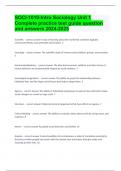
-
SOCI-1010-Intro Sociology Unit 1 Complete practice test guide question and answers 2024-2025
- Exam (elaborations) • 14 pages • 2024
- Available in package deal
-
- $12.49
- + learn more
SOCI-1010-Intro Sociology Unit 1 Complete practice test guide question and answers Scientific - correct answer A way of learning about the world that combines logically constructed theory and systematic observation. 5 Sociology - correct answer The scientific study of human social relations, groups, and societies. 5 Social embeddedness - correct answer The idea that economic, political, and other forms of human behavior are fundamentally shaped by social relations. 5 Sociological...
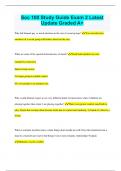
-
Soc 100 Study Guide Exam 2 Latest Update Graded A+
- Exam (elaborations) • 16 pages • 2024
- Available in package deal
-
- $9.99
- + learn more
Soc 100 Study Guide Exam 2 Latest Update Graded A+ Why did Simmel pay so much attention to the size of social groups? You can infer how members of a social group will behave based on the size. What are some of the special characteristics of dyads? Need both members to exist Guided by reciprocity Hard to keep secrets No larger group to exhibit control EX: two people in an intimate role Why would Simmel expect to see very different kinds of interactions when 2 children are playing together than ...
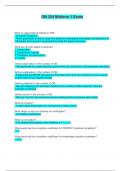
-
OB 354 Midterm 1 Exam | Verified with 100% Correct Answers
- Exam (elaborations) • 10 pages • 2024
-
- $15.99
- + learn more
OB 354 Midterm 1 Exam | Verified with 100% Correct Answers What is organizational behavior (OB) - A branch of science - More specifically a field of study that seeks to understand and explain the behaviors of individuals and groups in organizations using the steps of science. What are the four steps of science? 1. Observation 2. Explanation (theory) 3. Prediction (or association) 4. Control Define observation in the context of OB: - Job performance, organizational commitment, job motivation, ...
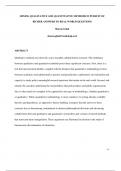
-
MIXING QUALITATIVE AND QUANTITATIVE METHODS IN PURSUIT OF RICHER ANSWERS TO REAL-WORLD QUESTIONS
- Exam (elaborations) • 37 pages • 2024
-
- $18.99
- + learn more
CONCEPUTALIZING QUALITATIVE, QUANTITATIVE AND MIXED METHODS Qualitative and quantitative research methods both involve an array of data types and techniques of analysis. Qualitative methods are associated with case studies, which may be historically and geographically bound events, organizational units or individuals, among others. Data regarding these cases may be drawn from participant or non-participant observations, from semi-structured interviews, focus groups or from narrative an...
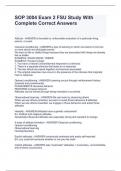
-
SOP 3004 Exam 2 FSU Study With Complete Correct Answers
- Exam (elaborations) • 9 pages • 2024
- Available in package deal
-
- $10.99
- + learn more
Classical conditioning - ANSWER-a type of learning in which one learns to link two or more stimuli and anticipate events We learn to like or dislike things because they are associated with things we already like or dislike. EXAMPLE; GOOD MOOD, TINDER EXAMPLE: Pavolov's Dogs 1. You have a natural (unconditioned) response to a stimulus 2. There is a separate stimulus that leads to no response 3. The two stimuli are paired together and become associated 4. The original response now occurs ...
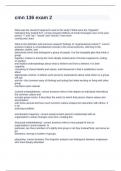
-
cmn 136 exam with correct answers 2024
- Exam (elaborations) • 14 pages • 2024
- Available in package deal
-
- $14.99
- + learn more
What was the research approach used in the study? What were the "linguistic" indicators they looked for? correct answers Millions of email messages over a five-year period. "I" and "we," "would" and "should," how much cursing was used. What is the definition and previous research findings of "organizational culture?" correct answers Culture is a foundational concept in the social sciences, referring to the attitudes, beliefs, and behavioral norms that distinguish a group of p...
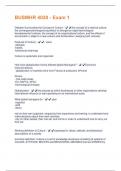
-
BUSMHR 4020 - Exam 1 Questions and Answers New (2024/2025) Solved 100% Correct
- Exam (elaborations) • 5 pages • 2024
-
- $7.99
- + learn more
Debates Surrounding the Concept of Culture - ️️the concept of a national culture, the convergence(homogenizing effect) or divergence (rapid technological development)of cultures, the concept of an organizational culture, and the effects of acculturation ( adapt to a new culture) and biculturation ( keeping both cultures). Features of Culture - ️️- value -attitudes -beliefs -behavioral meanings Culture is systematic and organized How have globalization forces affected global Mana...
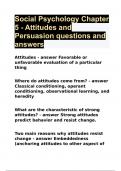
-
Social Psychology Chapter 5 - Attitudes and Persuasion questions and answers
- Exam (elaborations) • 13 pages • 2024
-
- $12.99
- + learn more
Attitudes Favorable or unfavorable evaluation of a particular thing Where do attitudes come from? Classical conditioning, operant conditioning, observational learning, and heredity What are the characteristic of strong attitudes? Strong attitudes predict behavior and resist change. Two main reasons why attitudes resist change Embeddedness (anchoring attitudes to other aspect of our selves) and commitment (people are more certain that the attitude is correct) Facto...
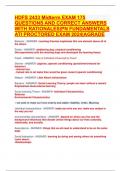
-
HDFS 2433 Midterm EXAM 175 QUESTIONS AND CORRECT ANSWERS WITH RATIONALES|PN FUNDAMENTALS ATI PROCTORED EXAM 2024|AGRADE
- Exam (elaborations) • 12 pages • 2024
-
Available in package deal
-
- $12.99
- + learn more
HDFS 2433 Midterm EXAM 175 QUESTIONS AND CORRECT ANSWERS WITH RATIONALES|PN FUNDAMENTALS ATI PROCTORED EXAM 2024|AGRADE Behavior - ANSWER- Learning theories emphasize this one element above all of the others Pavlov - ANSWER- slobbering dog; classical conditioning Did experiments with the drooling dogs and developed the learning theory Freud - ANSWER- View of individual influenced by Freud Skinner - ANSWER- pigeons; operant conditioning (punishment/reward for behavior) - skinner box ...

$6.50 for your textbook summary multiplied by 100 fellow students... Do the math: that's a lot of money! Don't be a thief of your own wallet and start uploading yours now. Discover all about earning on Stuvia


